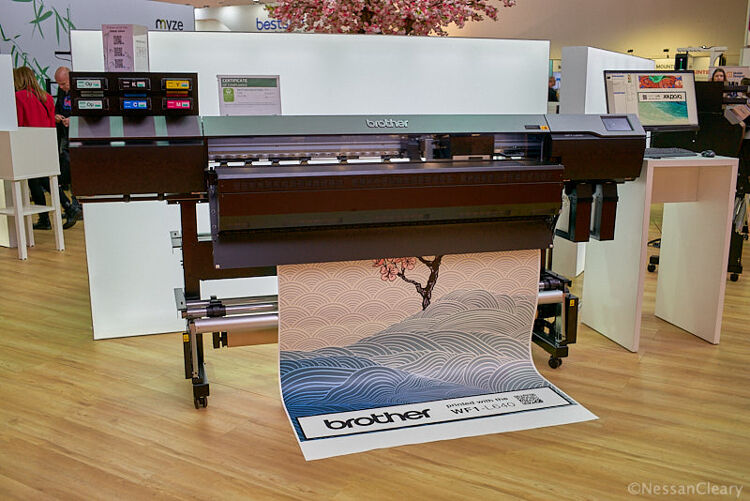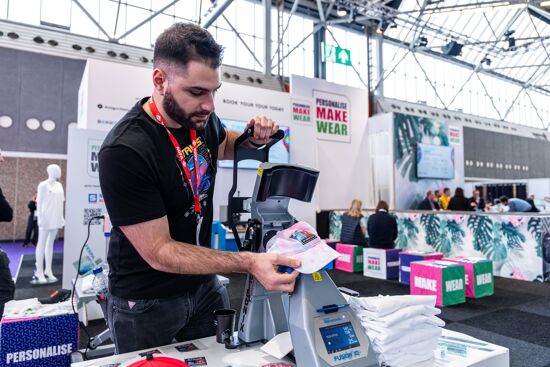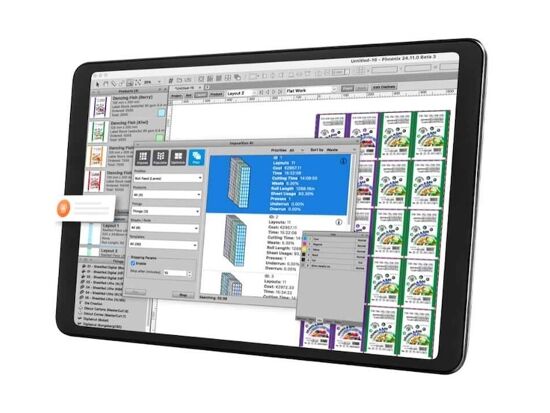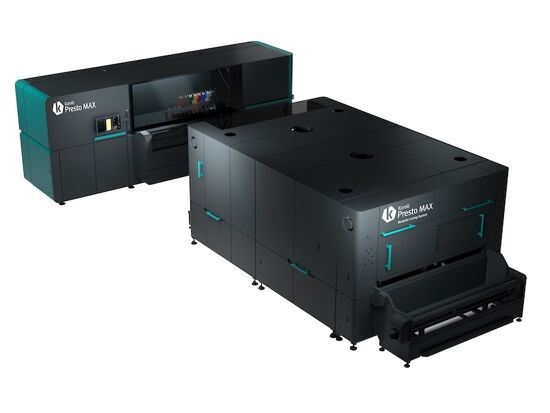The increasing use of resin inks in wide format printing

Nessan Cleary discusses how resin inks are becoming more popular in wide format printing. Resin inks can work with a vast variety of materials and can be used for both interior and exterior signage applications.
Inkjet ink can be loosely defined as pigment or colorant particles suspended in a carrier liquid that mainly serves to ensure the ink can be jetted through the tiny nozzles of the printheads to deliver the colourant to the media. For the most part, ink is generally classed according to this carrier liquid. In the early days of wide format inkjet, the dominant ink used a solvent carrier, which quickly gave way to UV-curable inks, partly because of regulatory restrictions on the use of solvent but mostly because of the advantages of UV inks.
However, now we are seeing a new class of resin ink starting to become more common. This uses water as its main carrier but there are now several different classes of water-based ink, including many textile inks. Sometimes this ink is referred to as latex, but the latex name itself comes from HP’s marketing team and the terms ‘latex’ and ‘resin’ both describe the same type of ink.
The basic idea behind a resin ink is that the pigment is encapsulated in a resin and that this resin melts when heated to bind the pigment to the substrate. As with UV-curable inks, resin ink will work with a wide range of different materials, both porous and non-porous including vinyl, banner, film, canvas, textiles and wallpaper and can be used for both interior and exterior signage applications including vehicle graphics.
 Caption: Epson's SureColor R5000 is a 1.6m wide roll-to-roll device that uses resin ink. Credit: Nessan Cleary.
Caption: Epson's SureColor R5000 is a 1.6m wide roll-to-roll device that uses resin ink. Credit: Nessan Cleary.
In most cases, the inkset includes a separate optimiser fluid with its own printhead channel. This allows the ink to work with a wide range of media, including both porous and non-porous. The optimiser is dropped onto the same locations that the colour ink drops will be jetted to and acts as a form of pretreatment that holds the wet ink drops in place on the media to prevent them from spreading before the heater melts the resin to cure the ink drops to the substrate surface.
However, the formulations for this class of ink do vary considerably from one manufacturer to the next, depending on the intellectual property they have access to and the applications they are targeting. So it doesn’t necessarily follow that all the various resin inks available have the same degree of capability, with more variation between ink makers than for other types of ink. Some offer better colour gamut, others are better for exterior signage uses and yet others will have lower energy consumption. As always, customers should carefully test any given printer with the exact media they plan on using to assess how suitable that printer is for their business.
Pros and cons
Most wide format vendors will market resin ink as a water-based ink that is more environmentally friendly than other types of ink. There are no volatile organic compounds or other hazards when working with this ink, and there are no barriers to recycling the finished prints. Of course, it should be noted that the overall sustainability depends heavily on the rest of the ink formulation.
However, the real benefit to resin ink is that there’s no need for a photo-initiator. In theory this should allow for a cheaper ink since photo initiators are expensive components. More to the point, the lack of photo initiators make resin inks more preferable to UV inks for food labelling and packaging as the photo initiators carry a risk of migration through the packaging to the food within. So it is the demand of the packaging industry that is driving the development of this ink as the water based resin inks are seen as a safer alternative that’s easier to put through the various certifications required for packaging for items such as food, some cosmetics and pharmaceuticals.
Consequently many ink makers are developing their own resin inks, which in turn is driving lower prices and making these inks more attractive to wide format printer vendors. For this reason we’re likely to see a lot more wide format printers being introduced with resin inks because many vendors are developing these inks anyway for packaging applications.
The main advantage in terms of wide format graphics is that there is no odour associated with them so that the prints can be used in more sensitive environments such as hospitals and schools as well as retail point of sale,
Unfortunately, since resin ink is water-based, it does come with the fundamental disadvantage that the water content must be dried out, meaning that a certain amount of heat has to be used. This in turn can limit the substrate range as some media are quite sensitive to heat. And of course more heat also leads to higher energy consumption - and therefore cost - for the heating elements. That said, the latest generation of inks use less heat and less energy.
Some vendors, for example, have separated out into an additional protective fluid those additives designed to protect the cured ink from scratches and abrasion. This helps to reduce the amount of liquid that is being laid down with the inks, which in turn reduces the amount of drying needed.
Resin ink in wide format
HP has made the most use of resin or latex ink, with its entire wide format portfolio from entry level through to flatbeds and 3.2m wide industrial printers all using this ink technology. That’s largely because HP’s inkjet printhead technology revolves around thermal printheads, which are not suitable for UV-curable inks.
 Caption: HP has gone on to develop latex flatbed printers such as this R2000. Credit: Nessan Cleary.
Caption: HP has gone on to develop latex flatbed printers such as this R2000. Credit: Nessan Cleary.
For now most other vendors have only used resin inks in cheaper roll-fed models, typically only up to 1.6m wide. This is mostly because they want an alternative to solvent printers in case legislation makes solvent ink printers more difficult to sell. However, most vendors admit that the energy needed to cure the ink all but wipes out the environmental advantage of not using solvents in the ink.
However, more vendors will develop resin inks for the packaging and labelling markets. This is partly because it’s easier to make an argument for the sustainability of these inks, but mainly because its easier to gain the necessary certifications for packaging sensitive products such as food and cosmetics. And many of those vendors are already involved in wide format printing and will want to spread their R&D costs.
At the same time, wide format printing has moved on from being purely about printing signage. You will see plenty of packaging applications at Fespa shows as well as examples of industrial printing such as decoration of other products, from household items to children’s toys. So it is inevitable that we will see more resin ink, or latex, printers turning up in the wide format market place.
Discover the latest innovations in inks and wide format printing at FESPA Global Print Expo 2025, Europe's leading print and signage exhibition taking place from 6 - 9 May at Messe Berlin, Germany. It will showcase the most innovative products, visionary concepts, and latest developments in the future of print. Register your interest to visit here.
Interested in joining our community?
Enquire today about joining your local FESPA Association or FESPA Direct
Recent news

Special Effects in DTF Will Make Your “Prints” More Memorable
The DTF market is expanding with new vendors and innovations like multi-head printers enabling diverse ink options (spot, neon). Decorative films offer streamlined special effects. Keypoint Intelligence tested metallic and glitter films, noting varied ease of use and wash durability. New technology using adhesive and foil directly promises further creative advancements in DTF.

SmartHub – Expectations, opportunities and why you should attend!
The SmartHub at Personalisation Experience 2025 in Berlin will showcase personalisation and smart production opportunities across industries like textiles. Featuring a Smart Factory Trail with brands like Inkcups and Trotec, and a conference with experts discussing AI, mass customisation, and profit strategies, it offers insights into reducing waste and boosting efficiency through digital methods. Panel sessions will explore growth, automation in textiles, and smart manufacturing.

How is AI revolutionising Large Format Print?
Nessan Clearly discusses how AI in print relies on data pattern matching, already enhancing software for large format providers. He predicts that this will result in increased AI integration in workflow planning, job queue management, colour correction, image upscaling, and predictive maintenance via sensors and vision systems, ultimately streamlining operations and offering greater flexibility.

One Ink for All? Exploring Pigment in Textile Printing
Digital textile printing faces complexity due to diverse substrates requiring specific inks. The industry seeks a universal ink, with pigment ink showing potential. While traditionally for natural fibres, advancements aim to broaden its application, simplify processes by reducing pre/post-treatment, and improve sustainability, though challenges like hand feel on garments remain.